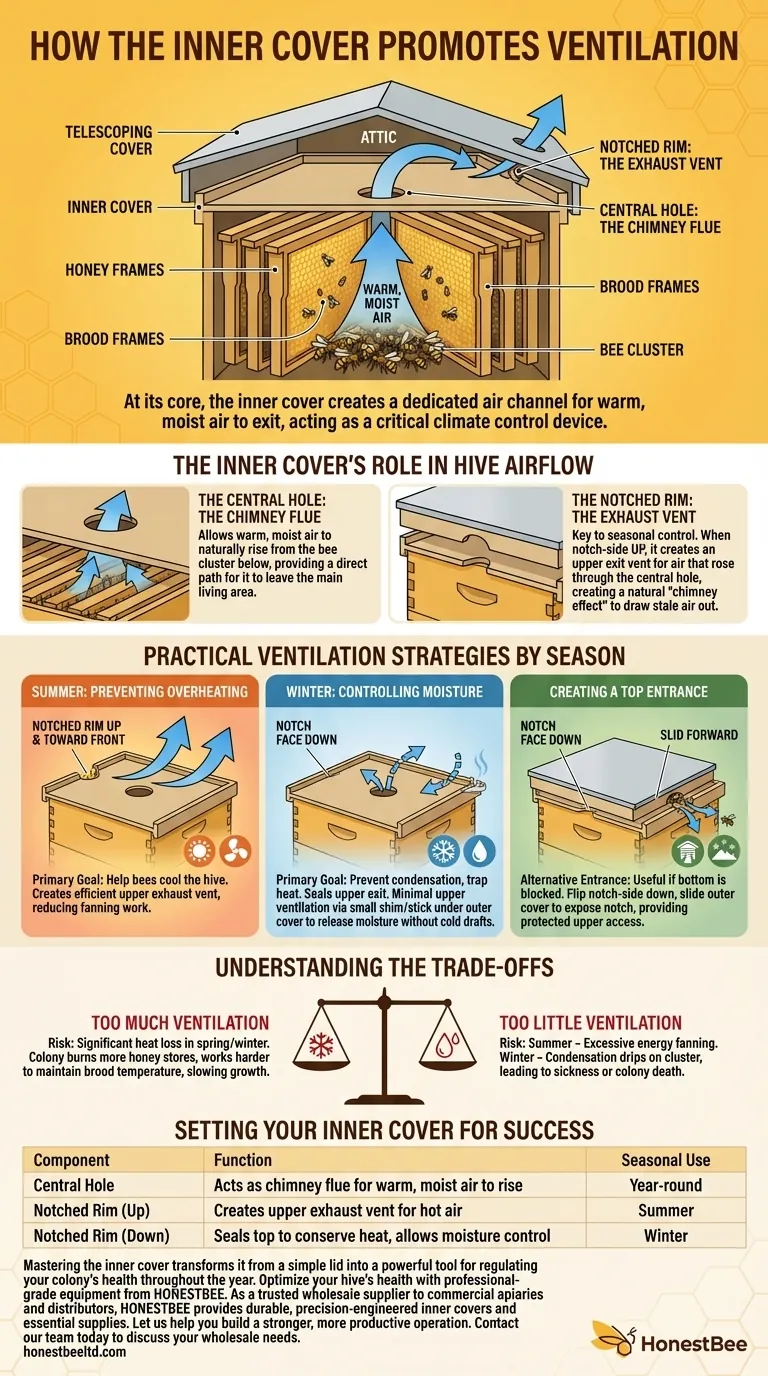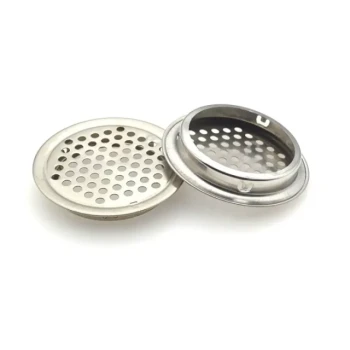At its core, the inner cover promotes ventilation by creating a dedicated air channel for warm, moist air to exit the hive. It features a central hole that allows air to rise from the brood chamber and a notched rim that, when oriented correctly, provides an escape route for this air from under the main hive roof.
The inner cover is not just a secondary lid; it is a critical climate control device. Understanding how to orient its central hole and notched rim is fundamental to managing both heat in the summer and moisture in the winter.

The Inner Cover's Role in Hive Airflow
The primary purpose of an inner cover is to create an insulating air gap between the top of the frames and the outer telescoping cover. This "attic" space is where ventilation is controlled.
The Central Hole: The Chimney Flue
The oval or round hole in the center of the inner cover acts like a chimney flue.
Warm, moist air, which is lighter than cooler air, naturally rises from the bee cluster below. This hole provides a direct path for that air to leave the main living area of the hive.
The Notched Rim: The Exhaust Vent
Most inner covers have a small notch cut into the rim on one of the shorter sides. This notch is the key to seasonal ventilation control.
When the inner cover is placed notch-side up, it creates a small gap at the front of the hive, just underneath the outer cover. This allows the air that rose through the central hole to exit the hive completely.
This setup creates a natural "chimney effect," constantly drawing warm, stale air up and out.
Practical Ventilation Strategies by Season
How you orient the inner cover depends entirely on the season and your specific goal.
Summer Ventilation: Preventing Overheating
During hot weather, your primary goal is to help the bees cool the hive.
Place the inner cover on the hive with the notched rim facing up and toward the front entrance. This creates the upper exit vent, allowing hot air to escape efficiently and reducing the fanning work the bees must do.
Winter Management: Controlling Moisture
In winter, the greatest danger to a colony is not cold, but condensation. Damp bees get chilled and sick.
Here, the inner cover's role shifts from cooling to moisture release. You typically place the inner cover with the notch facing down, which closes the upper exit. This helps trap precious heat.
However, some minimal upper ventilation is still needed to let moist air escape. Beekeepers achieve this by placing a small shim or stick under the outer cover, creating a tiny crack for moisture to vent without creating a cold draft.
Creating a Top Entrance
The inner cover can also be used to create an alternative entrance, which is useful if the bottom entrance gets blocked by snow or debris.
To do this, flip the inner cover so the notch faces down. Then, slide the outer telescoping cover forward just enough to expose the notch. This gives the bees a small, protected upper entrance and exit.
Understanding the Trade-offs
Proper ventilation is a balancing act. Getting it wrong can stress the colony.
The Risk of Too Much Ventilation
Excessive ventilation, especially during spring buildup or winter, can cause significant heat loss.
The colony must burn through more honey stores and work harder to keep the brood nest at its critical temperature (around 95°F / 35°C), slowing colony growth.
The Risk of Too Little Ventilation
In summer, insufficient ventilation forces the bees to expend massive amounts of energy fanning at the entrance, diverting them from foraging and other vital tasks.
In winter, it leads to condensation dripping back down onto the cluster. This is a primary cause of colony death during cold months.
Setting Your Inner Cover for Success
Your configuration should always be a deliberate choice based on the colony's needs.
- If your primary focus is maximum summer cooling: Place the inner cover notch-side up and to the front to create a reliable upper exhaust vent.
- If your primary focus is conserving heat in winter: Place the inner cover notch-side down to seal the top, but consider propping the outer cover to release moisture.
- If your primary focus is an emergency winter entrance: Flip the inner cover notch-side down and slide the outer cover forward to expose the opening.
Mastering the inner cover transforms it from a simple lid into a powerful tool for regulating your colony's health throughout the year.
Summary Table:
| Ventilation Component | Function | Seasonal Use |
|---|---|---|
| Central Hole | Acts as a chimney flue for warm, moist air to rise. | Year-round |
| Notched Rim (Up) | Creates an upper exhaust vent for hot air. | Summer |
| Notched Rim (Down) | Seals the top to conserve heat while allowing moisture control. | Winter |
Optimize your hive's health with professional-grade equipment from HONESTBEE.
Proper ventilation is key to a thriving apiary. As a trusted wholesale supplier to commercial apiaries and beekeeping equipment distributors, HONESTBEE provides the durable, precision-engineered inner covers and other essential supplies you need to master hive climate control year-round.
Let us help you build a stronger, more productive operation. Contact our team today to discuss your wholesale needs and discover how our products support superior colony health and honey production.
Visual Guide

Related Products
- Inner Beehive Cover for Beekeeping Bee Hive Inner Cover
- Stainless Steel Round Beehive Air Vents for Ventilation
- Professional Insulated Winter Hive Wrap for Beekeeping
- Professional Drop-Style Hive Handles for Beekeeping
- Professional Hive Front Entrance Bee Feeder
People Also Ask
- What is the function of the center hole in the inner cover? Master Hive Ventilation and Feeding
- What is the recommended orientation for the rim of an inner cover? Master Hive Ventilation and Insulation
- What is an inner cover in a beehive and what are its features? A Key Tool for Hive Health & Management
- What is the purpose of the inner cover in a beehive? A Key to Hive Health & Easy Management
- What is the function of an inner cover in a beehive? Essential for Hive Health & Management



















